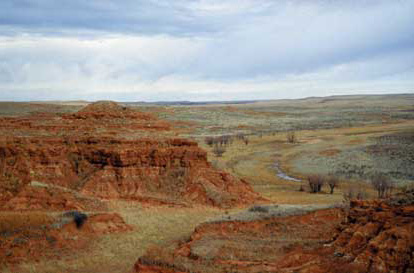A Place to Visit
Red Hills
![]()
Clark County,
Kansas

The buttes and mesas of the Red Hills don’t quite fit the stereotypical image of the Kansas landscape. The Red Hills, seen here along Keiger Creek in western Clark County, just north of U.S. Highway 160, extend across Clark, Comanche, Barber, and Harper counties. Their red color comes from the iron oxide in the shales, siltstones, and sandstones that were deposited during the Permian Period, about 270 million years ago. This part of Clark County is also characterized by sinkholes, formed when underground salt and gypsum deposits were dissolved by water and the land above fell into the empty space. One of these, Big Basin, is a mile across and about 100 feet deep. East of Big Basin, in a smaller sinkhole, is St. Jacob’s Well, a pool about 50 feet wide that has never been known to go dry. The road to St. Jacob’s Well is about three and a half miles south of the junction of U.S. Highways 160 and 283. For more information on the Red Hills or other physiographic regions of Kansas, see the Index of Physiographic Regions on the KGS Web site.

Kansas Geological Survey
1930 Constant Avenue, Campus West
Lawrence, Kansas
66047-3726
(785) 864-3965
-
Tom Collinson, Chair, Pittsburg
-
Robert Crangle, Lincoln
-
Dyan Jones, Prairie Village
-
Sheila Leiker-Page, Victoria
-
Jeffrey Mason, Goodland
-
Dennis McKinney, Greensburg
-
Stephen Morris, Hugoton
-
David Nance, Pittsburg
-
Marvin Odgers, Sublette
-
Larry J. Richardson, Wichita
-
John K. Strickler, Manhattan
-
William W. Hambleton, Emeritus Member, Lawrence
-
A. Scott Ritchie, KU Geology Assoc. Rep., Wichita
Director: Lee C. Gerhard
The mission of the Kansas Geological Survey, operated by the University of Kansas in connection with its research and service program, is to conduct geological studies and research and to collect, correlate, preserve, and disseminate information leading to a better understanding of the geology of Kansas, with special emphasis on natural resources of economic value, water quality and quantity, and geologic hazards.
The Geology Extension program furthers the mission of the KGS by developing materials, projects, and services that communicate information about the geology of Kansas, the state's earth resources, and the products of the Kansas Geological Survey to the people of the state
Online February 10, 2003
Comments to: lbrosius@kgs.ku.edu
Kansas Geological Survey
URL:http://www.kgs.ku.edu/Publications/GeoRecord/1998/vol4.1/Page4.html